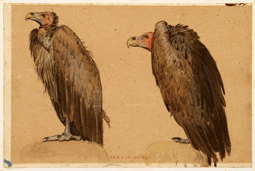Study of Two Vultures
Henry Stacy Marks (1829-1898). Watercolour on paper, 1877.
WorkOn receiving this study of two vultures, Ruskin wrote to Marks to thank him:'I jumped all about the room when I got your letter. I've been gloating like a good vulture over those vultures ever since I got them, and have got wilder and wilder about them every day; and I'm just going to show them in my lecture here on Tuesday as examples of true natural history drawing' (Works, 37, p. 229).
ArtistMarks was initially trained as a coach maker in London but was later allowed to train as an artist at the Royal Academy Schools and in Paris. From a young age, Marks had reasonable success as an artist but, as the son of poor parents, he supplemented his private work by painting large-scale domestic wall paintings. He also made designs for stained glass windows and ceramics, which were better paid. Marks helped design the massive frieze that runs around the Royal Albert Hall in London.As Marks's career proceeded, he became interested in birds. He studied them and drew from life from the specimens at London Zoo. He was a member of the 'St John's Wood Clique' a group of artists, based in London who became known for their practical jokes.Marks and Ruskin first met in 1856 and over the next two decades they grew to be friends. Once Marks became an established artist, the relationship cooled: Ruskin had continued to send Marks unwanted advice and demands for work.Nevertheless, Ruskin and Marks shared an interest in the accurate representation of nature, and in the portrayal of birds in particular. Collection of the Guild of St George, Museums Sheffield
During 1877, Marks was working on wall paintings that included birds, for the Duke of Westminster. He sent five studies of these birds to Ruskin, in recognition of his position of Slade Professor of Fine Art at Oxford. Ruskin was delighted with these studies and added them to his teaching collection at Oxford. Despite Ruskin's requests for more, it seems that Marks did not send him a sufficient number for use in lectures and lessons. In consequence, Ruskin decided to send the studies he had received on to Sheffield.
Ruskin on BirdsRuskin often wrote about birds. In Love's Meinie (1881), he devoted a whole book of lectures to their study.An interest in birds' feathers is found throughout his work. Ruskin contrasted birds' clumsiness when feeding or on the ground with their perfection in flight. He concluded that their anatomical mechanisms were specially geared towards flying or life in trees, rather than existence on land.It was for this reason that Ruskin concentrated his observations on the beauty of bird structure, colour and feathers. |



















